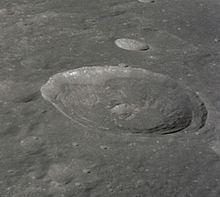This article includes a list of references, related reading, or external links, but its sources remain unclear because it lacks inline citations. (May 2024) |
 | |
| Coordinates | 5°42′S 2°06′W / 5.7°S 2.1°W |
|---|---|
| Diameter | 39 km |
| Depth | 3.8 km |
| Colongitude | 3° at sunrise |
| Eponym | William Herschel |



Herschel is a lunar impact crater located just to the north of the walled plain Ptolemaeus. Its diameter is 39 km. It was named after German-born British astronomer William Herschel.[1]
Just to the north is the flooded crater Spörer, and around 30 km due east lies the disintegrated crater Gyldén. About a crater diameter to the northwest (35 km) is the walled plain Flammarion, along the southern edge of the Sinus Medii.
The rim of this crater is generally circular, although the western side is straight. It has a well-defined edge that is not significantly worn, and the inner walls are terraced. On the rough inner floor is a notable central rise. This peak is offset slightly to the west of the crater midpoint. The small crater Herschel G is attached to the south-southwest rim, and a tiny craterlet lies across the southern rim.
Herschel is a crater of Eratosthenian age.[2]
- ^ "Herschel (lunar crater)". Gazetteer of Planetary Nomenclature. USGS Astrogeology Research Program.
- ^ The geologic history of the Moon. USGS Professional Paper 1348. By Don E. Wilhelms, John F. McCauley, and Newell J. Trask. U.S. Government Printing Office, Washington: 1987. Table 12.2.